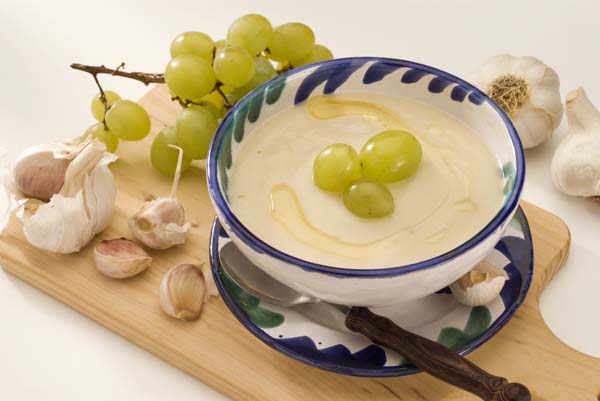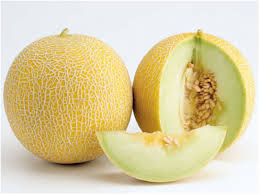Cold soups, like salads, are dishes I crave for in the summer months, so here are a few proposals that are slightly different from your standard gazpacho which we looked at last week. They are really easy to make so you can easily make them in advance and cool them in the fridge for later.
1. // This first recipe might surprise you because of its ingredients but its taste will also surprise you. Roasted peppers, watermelon and basil make a wonderful blend; the fruit brings a unique freshness to the dish. It is garnished with crispy croutons and boiled egg. You could also add Serrano ham or even ‘mojama’; salted fish. Roasted peppers and basil marry together perfectly but make sure the basil is fresh and the watermelon is flavoursome.
Roasted Peppers, Watermelon & Basil
 11.13.35 - Copy 1.png)
To make the soup you will need:
Ingredients (4 servings)
400 grams of roasted peppers (red bell peppers),
200 grams of roasted pepper juice
250 grams of watermelon
2 cloves garlic,
Fresh basil,
Extra virgin olive oil
Black pepper
Salt.
Garnish :
4 eggs, croutons, extra virgin olive oil, champagne vinegar (optional).
Make sure you have enough time to roast the peppers and let them cool down before making the recipe. To roast them, clean them inside and out but leave them whole and place them on a tray covered with tin foil and roast them at 200ºC for about an hour or until they are tender, turning them over half way through the cooking time.
Turn off the oven and leave them until they are cool then peel them, remove any seeds and recover the juice that that has been released by the peppers, this will help lighten the soup but maintain its flavour. Place the peppers and half of the juice in the blender.
Cut the watermelon into cubes, remove the skin and seeds and add it to the peppers in the blender. Peel the garlic cloves, cut them length ways and remove the central roots and add them the blender along with several basil leaves, the amount depends on how much you like the flavour of this aromatic plant. So blend and taste.
Blend until it is creamy and add a trickle of extra virgin olive oil, salt and freshly ground black pepper. Blend again to emulsify. Now you can add the rest of the roasted pepper juice depending on how thick you want the soup to be. Add and blend until you get the consistency you want. Taste for salt and pepper and then store in the refrigerator.
Make 4 hard-boiled eggs; cool them off in cold water. Peel the eggs and separate yolks and whites, grate the yolks and dice the whites to sprinkle on top of the soup.
Season the croutons with a little extra virgin olive oil and a few drops of vinegar for a touch of acidity. Finally add a few leaves of basil before serving and a slight drizzle of Picual extra virgin olive oil.
2. // This next soup is a Spanish classic; The Ajoblanco, which is like gazpacho or Salmorejo in that every cook has their own proportions and their slight differences but is unique in flavour and always a favourite. I like Ajoblanco with a slight thick and creamy texture, and that is how I am going to share it with you today. This soup is believed to have originated with the Romans and I can assure you any garlic lover will be asking for seconds so make plenty of it.
Ajoblanco

Here are Ingredients (4 servings):
½ Litre mineral water
250 grams of peeled almonds (to peel them scald them in boiling water). You can use chopped almonds too.
2 cloves garlic (not too large)
A piece of bread from the previous day (the amount needed will depend on the texture you want)
Sherry vinegar
Extra Virgin Olive Oil - Arbequina
Salt.
Again this a recipe that creates hardly any work and if you have a half decent blender you’ll get a velvety texture, however the real Ajoblanco was made with pestle and mortar, only to be done if you fancy a tough workout.
So to save time introduced into the blender the water, the bread, the peeled almonds and garlic, blend them and then emulsify with olive oil, adding it little by little. Finally add the sherry vinegar and salt.
Taste and rectify accordingly if necessary and then pass the soup through a fine sieve. Cool in the refrigerator until ready to serve.
Usually you can accompany the Ajoblanco with grapes or melon, however you can also garnish with anchovies or ham, eggs and a few drops of sesame oil, tomatoes or just with fish roe and a sprig of parsley. There is nothing written in stone so here you can leave your mark.
3. // The last soup today is another recipe that uses melon. Melon goes very well with nuts and also with mint and peppermint, and if we add a touch of flavour with the crispy Serrano ham you can imagine that the combination becomes very interesting. So you must try this recipe soon while the summer is still here.
Melon, Almonds & Mint
 11.15.16 - Copy 1.png)
Ingredients (4-6 servings)
 900 grams of Galia Melon
900 grams of Galia Melon
120 grams of almonds (can be whole, chopped or ground)
2 cloves garlic
6 mint leaves (10-12 spearmint)
Black pepper
Salt
40 grams of extra virgin olive oil
Garnish:
Melon balls, cherry tomatoes, crispy Serrano ham bits, small mint leaves, extra virgin olive oil.
Thoroughly wash the melon, dry it, cut it in half and remove the seeds. Make some melon balls using a Parisian spoon and put to one side. Next remove the skin and place the melon fruit, chopped up, into the blender. Peel the garlic, remove the central root inside and add to the blender, add the peeled almonds and mint leaves and finally salt and pepper. Blend into a fine and homogeneous soup.
Add the extra virgin olive oil and blend into an emulsion. Keep the melon soup in a glass covered container until it has chilled. When ready to serve add a cherry tomato and one or two melon balls a couple of mint leaves. Serve melon soup and garnish with almonds, a cherry tomato and one or two balls of melon, a few mint leaves, a sprinkle of crispy ham and a drizzle of extra virgin olive oil.
Enjoy!